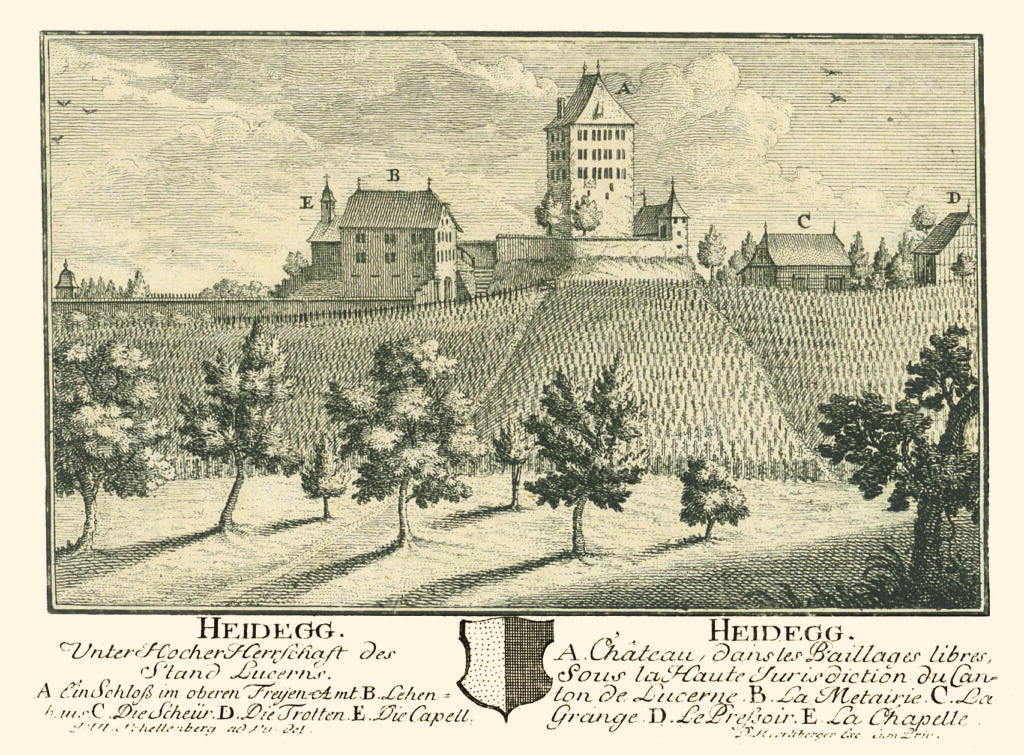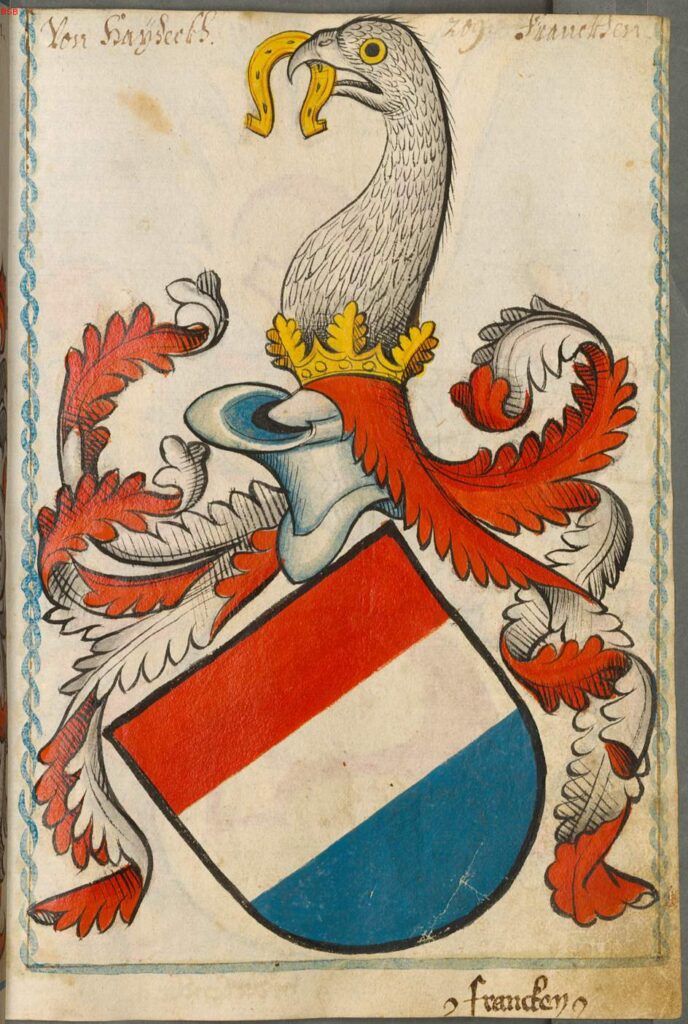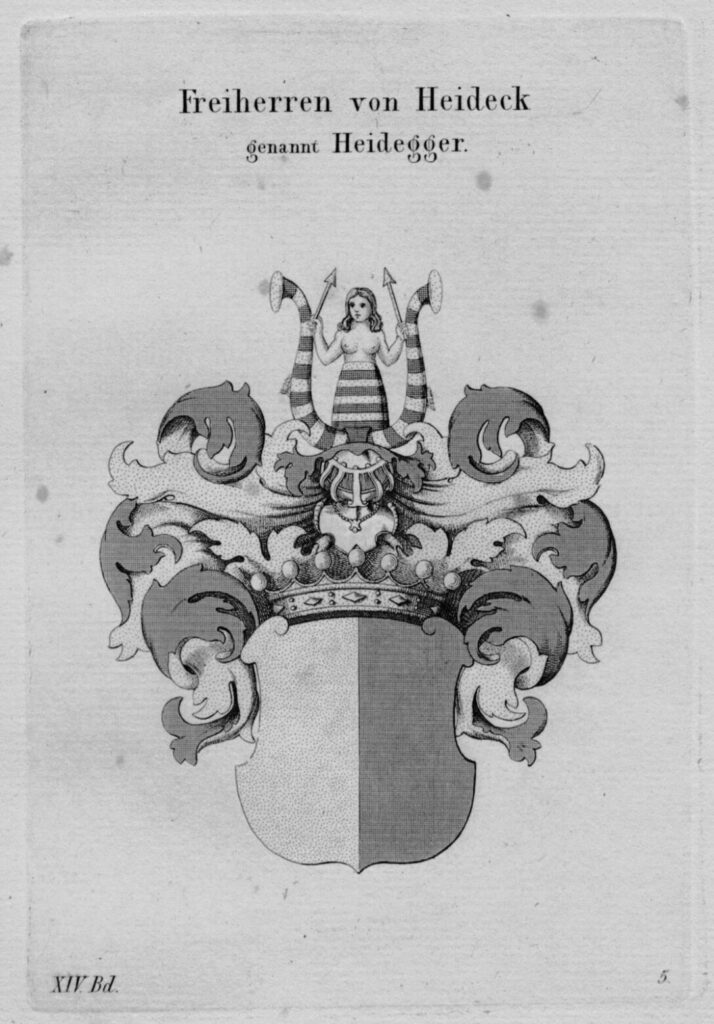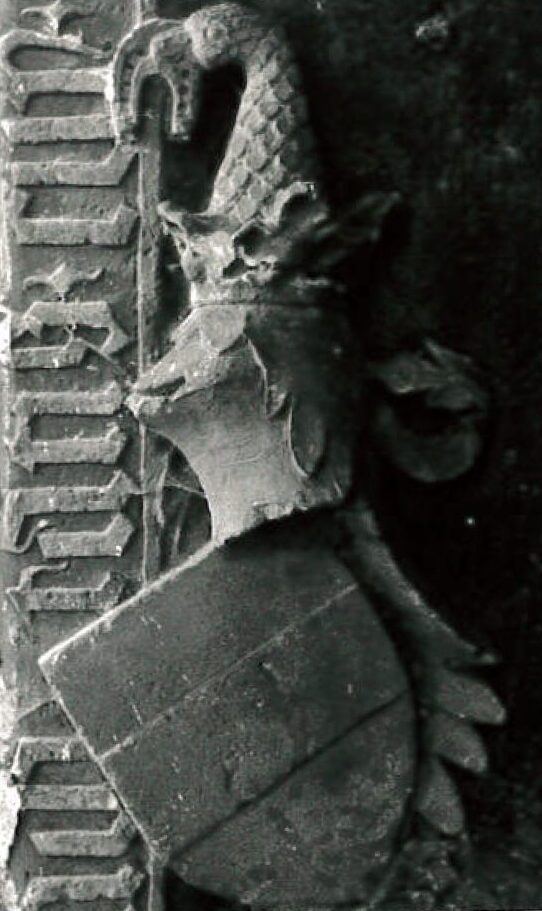Heydecker Family Record
The Heydecker Family Record goes back to 763 A.D.
The Schloss Von Heidegg

Schloss is the German word for castle or stronghold. Heideck, Heydeck, or Heidegg, as it is sometimes styled, is a lordly keep, proudly situated within one of the free bailiwicks of Switzerland. From this very stronghold, the family that bears its name did flourish and spread forth in ages long past.
Indeed, many a year ago, branches of this noble line did settle in the Canton of Zurich, where they raised a castle hold near the Monastery of Embrach, bestowing upon it the very name of their ancestral seat.
The Multiple Coats of Arms
In Germany, Coats of Arms are traditionally developed following heraldic rules and often reflect the history, profession, or social status of the individual or family. Typically, the design process involves choosing symbols, colors, and motifs that represent personal achievements, regional affiliations, or family heritage. The creation and registration of a Coat of Arms are overseen by heraldic authorities or associations to ensure uniqueness and adherence to heraldic traditions. Historically, noble families and individuals were granted the right to bear arms, but today, anyone can design a Coat of Arms, provided it respects existing heraldic customs.



Official Records Mentioning the von Heydeck/ Heidecker/ Heidegger/ von Heidegg/ Heydecker Name Since 763
Whilst a direct line of descent across all bearing these names cannot be definitively traced, these names, dates, locations, etc., concerning the Heidecker family, their genesis and subsequent expansion, have been faithfully recorded from unimpeachable sources within the Vienna Bible itself.
It is therein chronicled that the family of Heidecker traces its origins to the Netherlands, where the very first mention of this name is found within the annals of Adam of Bremen. This progenitor was known as Ettel or Zttel, and he dwelt in the forest of Ardennes, around the year of our Lord 763, within the fortress of Heideck, where he took Elsbeth Gobbelsehroy as his bride. Upon a craggy cliff, he raised a formidable fortress to shield himself from the incursions of the heathen Frisians, naming it Heideck, meaning Heathencliff. In his conflicts with these Frisians, he captured their Duke, Withorn, meaning White Horn. As a reward for this valorous deed, the Franconian King Charlemagne bestowed upon him the feudal ownership of the castle and the estate of Ohtenhid, upon the Frisian border.
It is for this very reason that his helmet was adorned with a white buffalo horn, the Withorn, and his shield bore a willow tree, alongside the ancient emblem of his house, a buffalo head. These symbols were adopted by his descendants as their coat of arms and were secured to them by a heraldic patent granted by the German King, Conrad the Third.
Notable von Heydeck/Heidecker/ Heidegger/von Heidegg/ Heydeckers
Friedrich von Heydeck

Hark, and listen well to the tale of Friedrich von Heydeck (whose name appears in the records from 1367, and who departed this life in 1423). This Friedrich received special family privileges from King Wenzel in the year 1387, and further honors from the German King Ruprecht in 1402. Yet, even with these distinctions, he wrestled with the persistent financial burdens that had long weighed upon his house. The ravages of invading hordes, the sorrow of plagues, and the violence of the times also cast a shadow upon his possessions, threatening their security.
In a pious act, Friedrich bestowed his generosity upon the women’s chapel in Heideck, which now serves as his final resting place. Therein, his tombstone depicts him in full armor, rendered near life-size and remarkably preserved. I myself visited this sacred place and captured various images within the chapel, including a likeness of Friedrich’s statue, of which I present the head here for your contemplation.
Within this very same chapel also lies the tomb of his daughter-in-law, a noblewoman by the name of Sibylle von Ortenburg, who passed away in the year 1475. Furthermore, a fresco was uncovered within these walls in 1960, having been concealed beneath layers of plaster. It is believed, with good reason, that this artwork portrays Heideck Castle itself and bears the inscription of the year fourteen hundred and fourteen.
Verified Direct Line Ancestors
This confirmed lineage has been documented by a number of Keepers, from the original Kempten family who conducted and preserved their family research. Most notably:
- Marcus Heydecker, 1697-1777, a Papermaker in Kempten, Germany.
- Alfred Heydecker, 1858-1927, Chief Customs Officer in Augsburg, Germany.
- Edward Le Moyne Heydecker, 1863-1914, Attorney in Philadelphia, PA, U.S.A.
- Christian Townsend Heydecker, 1846-1926, Attorney in Waukegan, Illinois, U.S.A.
- Joseph Julius Heydecker, 1916-1997, Journalist and Writer in Nuremberg, Germany.
- Margaret Heydecker Foreman, 1919 – 1998, Humanitarian and Traveler in Pelham Manor, NY, U.S.A.
- Patricia Ann (nee Glynn) Heydecker, 1939 – 2016, Architectural Designer in Foxborough, MA, U.S.A.
- Jeanne-Elise Marie Heydecker, born in 1960, Strategic Business Consultant in Chicago, IL, U.S.A., India, Myanmar, and Singapore